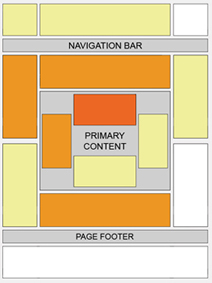1. Try placing your ads under the hot spots. Text ads work good when blended within the content. Try using text and image ads for a week and check the CTR.
While this heat map is useful as a positioning guideline, we strongly recommend putting your users first when deciding on ad location. Think about their behavior on different pages, and what will be most useful and visible to them. You'll find that the most optimal ad position isn't always what you expect on certain pages.
For example, on pages where users are typically focused on reading an article, ads placed directly below the end of the editorial content tend to perform very well. It's almost as if users finish reading and ask themselves, "What can I do next?" Precisely targeted ads can answer that question for them.2. The more better content, the more click on ads
3. Section targeting
Section targeting allows you to suggest sections of your text and HTML content that you'd like us to emphasize or downplay when matching ads to your site's content. By providing us with your suggestions, you can assist us in improving your ad targeting. We recommend that only those familiar with HTML attempt to implement section targeting.
To implement section targeting, you'll need to add a set of special HTML comment tags to your code. These tags will mark the beginning and end of whichever section(s) you'd like to emphasize or de-emphasize for ad targeting.
The HTML tags to emphasize a page section take the following format:
<!-- google_ad_section_start -->
<!-- google_ad_section_end -->
You can also designate sections you'd like to have ignored by adding a (weight=ignore) to the starting tag:
<!-- google_ad_section_start(weight=ignore) -->
With these tags added to your HTML code, your final code may look like the following:
<html><head><title>Section targeting</title></head>
<body>
<!-- google_ad_section_start -->
This is the text of your webpage. Most of your content resides here.
<!-- google_ad_section_end -->
</body>
</html>
You can use section targeting to make suggestions about as many sections of a page as you like. However, please be aware that we can't guarantee results, and that it may take up to 2 weeks before our crawlers take into account any changes you've made to your site.
In order to properly implement this feature, you'll need to include a significant amount of content within the section targeting tags. Including insufficient content may result in less relevant ads or PSAs. In addition, please keep in mind that this feature should only be used to emphasize significant sections of your site's relevant content. It is against our program policies to manipulate the ad targeting to result in ads that are not relevant to the content of your pages.




No comments:
Post a Comment